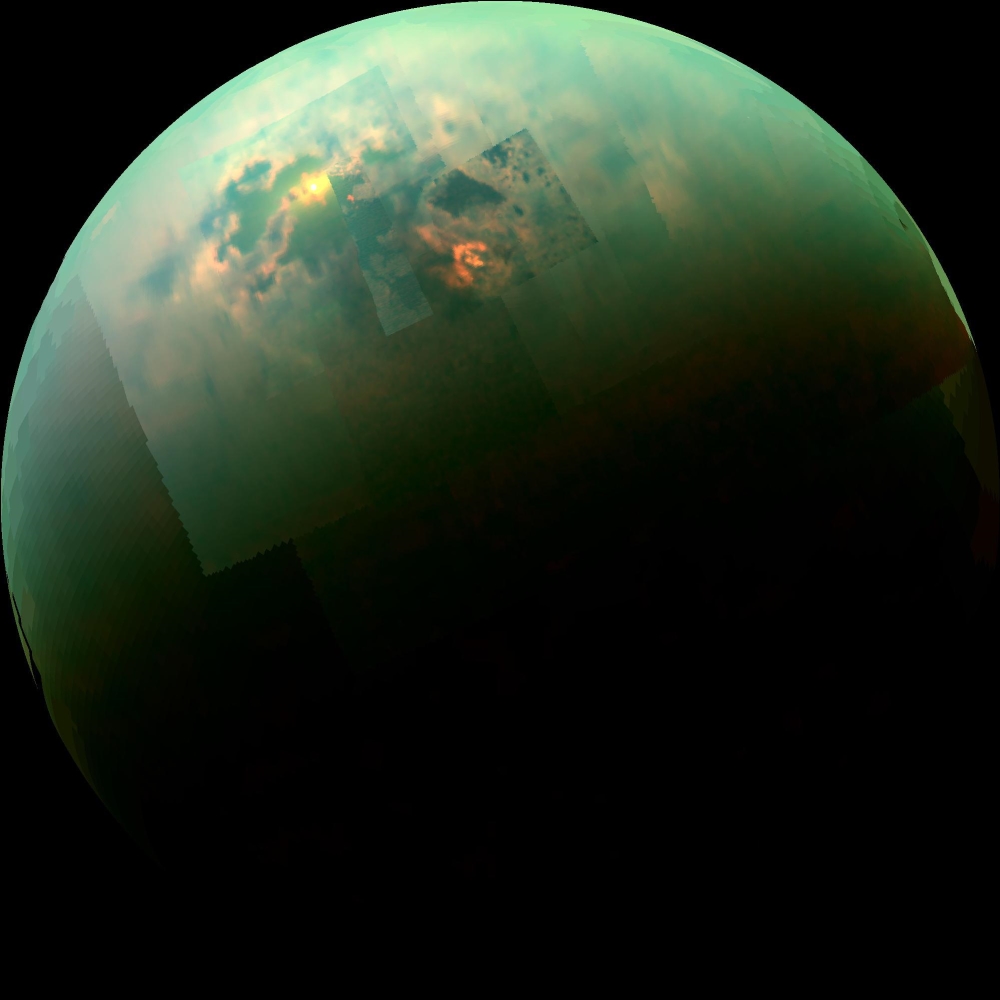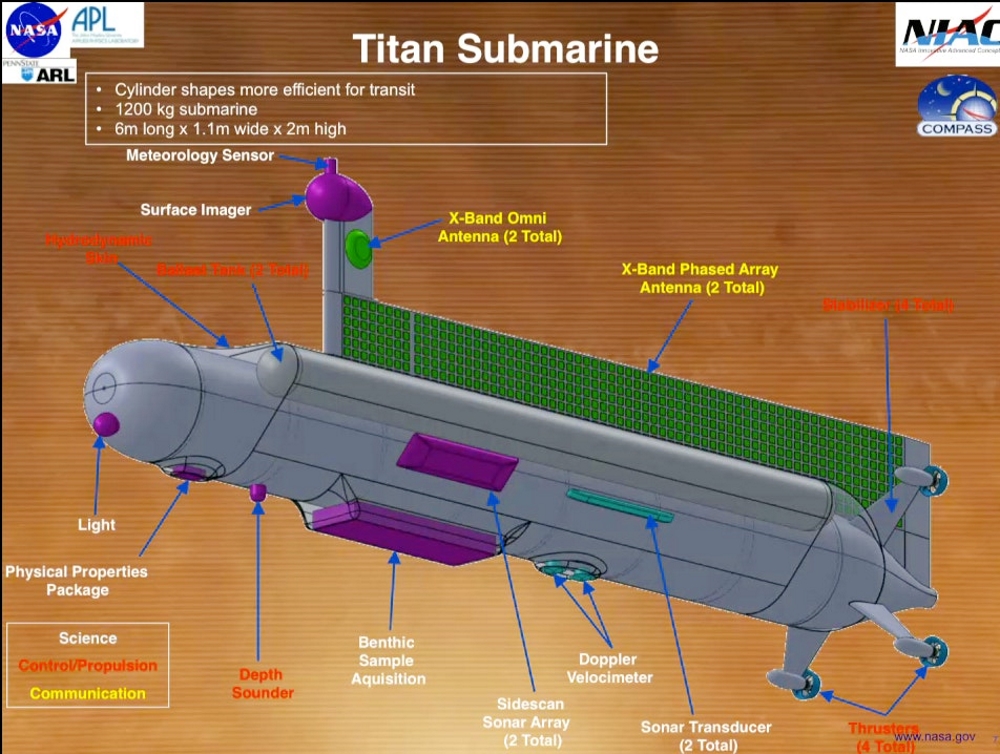A Little Robotic Submarine Could Ply Alien Seas
NASA is designing a robot submarine to explore the ultrachilly, hydrocarbon-filled seas on Saturn's moon Titan — the only body in the solar system, apart from Earth, with liquid on its surface. Researchers have been testing the probe with a bucket-sized mock alien ocean in a lab.
The seas of Titan are very different from their counterparts on Earth: instead of seawater, Titan's seas consist mainly of a frigid mixture of methane and ethane, at a temperature of around minus 300 degrees Fahrenheit (minus 184 degrees Celsius). That's what NASA's Cassini spacecraft and its Huygens probe, which landed on Titan in 2005, found.
The plan is to send the autonomous submarine into the largest sea on Titan. called Kraken Mare, from the name of a Scandinavian sea-monster and the Latin word for "sea," the extraterrestrial sea covers 155,000 square miles (400,000 square kilometers) of the moon's surface. (The second-largest sea on Titan, about a quarter the size of Kraken, is Ligeia Mare, named after one of the monstrous sirens of Greek mythology.) [See Photos of Titan's Oceans]

These dives could answer some of the questions that keep scientists, at least those studying Titan, up at night. For instance, how do Titan's hydrocarbon seas interact with the moon's atmosphere, which is more than 98 percent nitrogen? That's what Ian Richardson, a materials science engineer at Washington State University, wanted to know. Richardson built the alien ocean simulator for NASA's Titan submarine project.
"Unlike on Earth, that nitrogen does actually dissolve significantly into those oceans," Richardson told Live Science. "You can get 15 or 20 percent dissolved nitrogen, which can have a huge effect on the ballast systems and propellers."
Alien oceans
Although engineers on Earth have studied cold ethane and methane mixes in the form of liquefied natural gas (LNG), no one has looked at how seas of such hydrocarbons would behave in a cold, mainly nitrogen atmosphere like that on Titan, Richardson said.
To learn more about how Titan's alien oceans would affect a robot submarine, Richardson built a pressurized chamber, pumped it with nitrogen gas, and poured in about 60 cubic inches (1 liter) of liquid ethane and methane, cooled to minus 300 degrees F. This was done at a cryogenics engineering laboratory at Washington State University.
Sign up for the Live Science daily newsletter now
Get the world’s most fascinating discoveries delivered straight to your inbox.

He then submerged a small, cylindrical heater (the "robot sub") in the liquid (the "alien ocean"). Richardson varied the model ocean's temperature and pressure to see how heat from a sub would affect the chemistry of Titan's seas at different depths.
Richardson explained that the heat would create bubbles of dissolved nitrogen gas in the liquid surrounding the submarine, which could make observations via the onboard cameras difficult. The bubbles of nitrogen could also prevent the sub's buoyancy and propulsion systems from working properly, he said.
Richardson's simulator was also able to mimic the chemical composition of Titan's different seas. All of Earth's oceans are filled with essentially the same seawater, but that's not the case for Titan's seas, the Cassini probe observations revealed. For instance, Kraken Mare is rich in ethane, while Ligeia Mare is rich in methane, though scientists aren't sure why.
Titan Turtle
The experiments with the alien-ocean sub indicated that a submarine probe would be able to deal with the bubbles of nitrogen created by the craft's own heat source in the frigid liquid. The worst conditions, the experiments revealed, would be found at the greatest depths of Kraken Mare, at least 1,600 feet (500 meters) below sea level. [Amazing Photos: Titan, Saturn's Largest Moon]
If the mission is approved, the probe could be launched in the mid-2030s and arrive at the Saturn system in the late 2030s or early 2040s, one of the project leaders at NASA's Glenn Research Center, aerospace engineer Jason Hartwig, told Live Science.
At that time, the distant and frozen moon should be slightly warmer and sunnier than it is now, thanks to the local equivalent of Earth's springtime. At that time, the Saturn system — which takes 29 Earth years to complete one orbit — will be slightly closer to the sun, Hartwig said.
Hartwig's team is working on two different designs for the robot probe: One is a narrow robot submarine around 20 feet (6 m) long that would surface to send data directly back to Earth. The other is the Titan Turtle, a round-shelled, autonomous bot that would communicate with Earth through an orbiting spacecraft.
While the solo submarine probe would be cheaper, the Turtle and orbiter design would be less risky and would have more bandwidth for sending data back to Earth, Hartwig said.
The project recently moved from the first phase of experimental funding under the NASA Innovative Advanced Concepts (NIAC) program. It's now moving toward the technology-development stage, with initial tests of some systems planned for late 2018 or early 2019, Hartwig said.
Original article on Live Science.
Tom Metcalfe is a freelance journalist and regular Live Science contributor who is based in London in the United Kingdom. Tom writes mainly about science, space, archaeology, the Earth and the oceans. He has also written for the BBC, NBC News, National Geographic, Scientific American, Air & Space, and many others.










